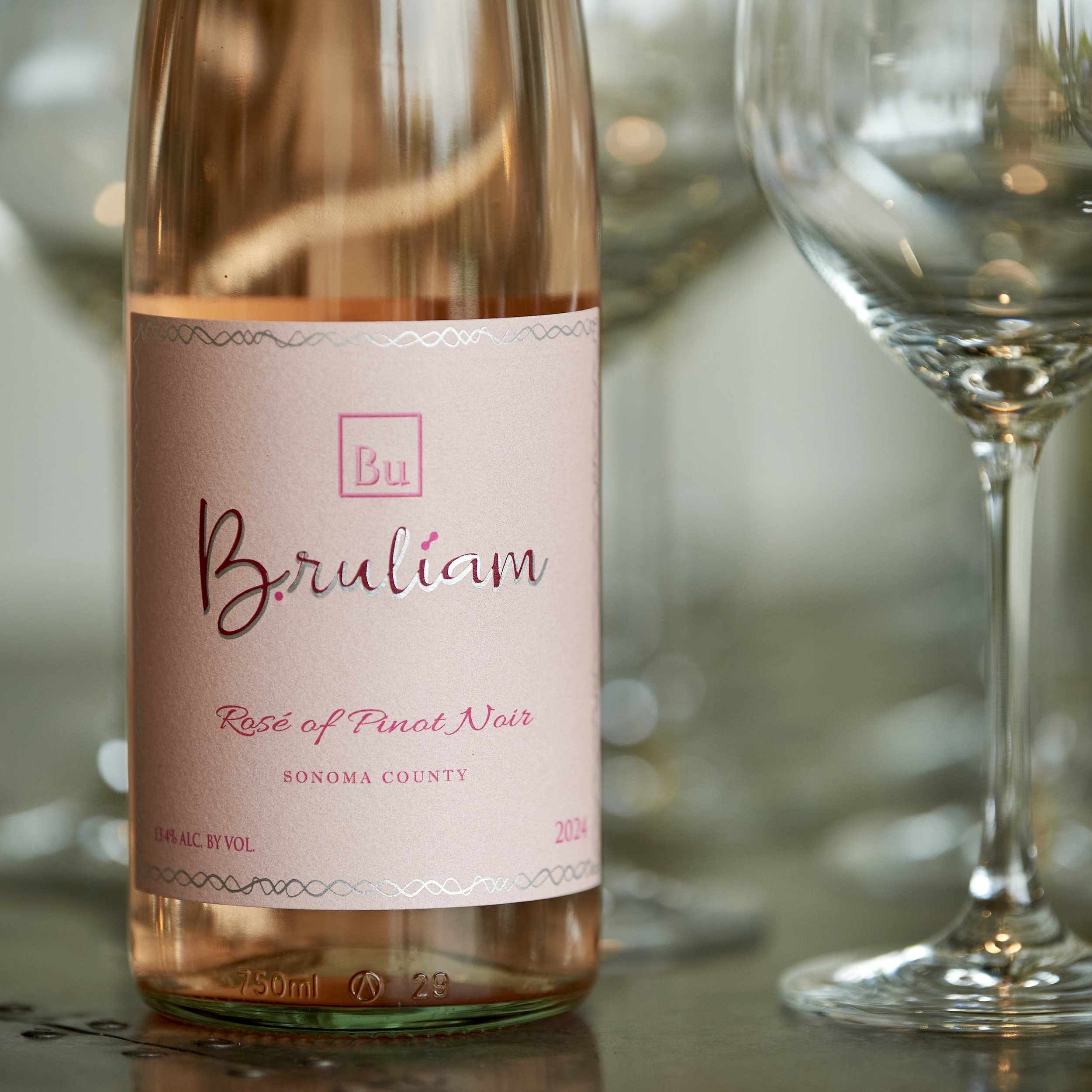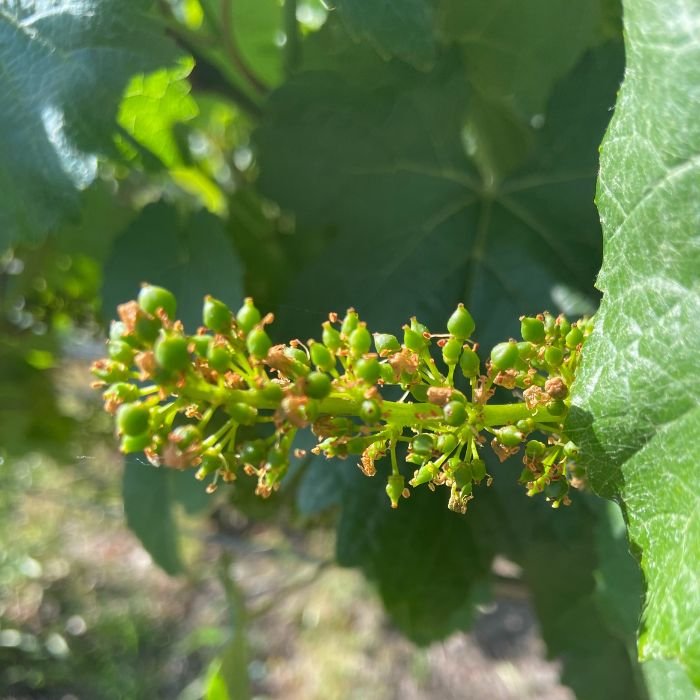What’s Blooming at Bruliam (hint: library wine release opens June 2!)
a teaser of what’s to come
Early fruit set at Torrey Hill looks great. I’m seeing complete clusters with minimal shatter. This portends well for harvest 2025. And just to tempt fate, to tickle the whimsy of Demeter, and push our God-given luck, I’ll submit that every season is a great season in Sonoma County. And library wine season is among our favorite seasons of all.
2025: early fruit set at Torrey Hill Vineyard. Strong set portends a happy harvest.
On June 2nd, we will open the Bruliam Wines library to re-offer 5 great wines that speak to terroir, vintage, and site. We have fewer than three cases of some, so please stay tuned for login and purchasing instructions.
Re-releases will include:
2018 Gap’s Crown Vineyard pinot noir
2019 Gap’s Crown Vineyard pinot noir
2019 Sangiacomo Vineyard pinot noir
2019 Heintz Vineyard chardonnay
2020 Torrey Hill Vineyard pinot noir (a rare triumph in a tough vintage)
Stock up on rose for summer. The acclaimed ‘24 vintage won’t last long.
stock up on summertime favorites
Opportunities to purchase our super-delicious 2024 rose of pinot noir and our finger-licking 2022 Rockpile zinfandel will be included in the link.
read on for a primer on bloom, pollination, germination & fruit set
Here in Sonoma County, bloom is bursting. In fact, Sonoma’s earliest chardonnay sites first identified bloom at the end of April. With our ideal weather, bloom zipped along from rare flowers to 30% inflorescence within a week. In fact, the earliest ripening sites already have evidence of fruit set, and ’25 yields look robust. Here at Torrey Hill vineyard, 2025 bloom aligns within a few days of my 2024 metrics. In 2024, I documented early bloom May 2-3; this year I detected <5% bloom around May 7th.
Bloom!
Why does it matter?
Farmers like to measure stuff. Winemakers like to feel prepared. Most critically, flowering and fruit set are the principal determinants of yield. More flowers = better fruit set = more grapes. In general, bloom happens 6-8 weeks after bud break. Bloom typically lasts 1-3 weeks, depending on weather. Here at Torrey Hill, most of our clusters have progressed from bloom through pollination to fruit set, while <5% of vines remain in anthesis (bloom). In general, we count down 100-110 days from bloom to harvest. In general, we can’t rely on “average weather” anymore. But sunshine and degree days still matter. Nonetheless, it’s nice to pretend like we’re in control.
Good fruit set; minimal shatter.
What Can We Control?
To maximize flowering and fruit set, growers have a few levers at our disposal. While we cannot control the weather, we know that shaded clusters display diminished fruit set. As such, we can initiate the cultural practices that maximize sun exposure on the buds. Examples include pulling any laterals that cause excessive shading and securely trellising tall shoots to prevent flop-overs (thereby excessive shading). We know that drought during bloom increases berry abscission (i.e. failure to set). We can irrigate in advance of bloom of necessary. The 2022 vintage is a good example of a dry year that necessitated early irrigation.
VSP trellis keeps tall, happy, green shoots upright and in place.
Growers can use foliar sprays that contain trace vitamins (boron, Zn) or plant-based amendments. Seaweed, for instance, contains potassium and pro-growth plant hormones like gibberellins & cytokinin. Anecdotally, these plant hormones also help vines mitigate abiotic stress. At Torrey Hill, we apply compost tea in advance of bloom. At Nightwing Vineyard, the viticulturalists arc the canes both to prevent young shoots from wind damage and to effect hormonal change, boosting mid-cane fruitfulness. Having these tools offers us winegrowers an illusion of control.
Weather Matters Most
We have no practical control over the weather. The ideal window for flowering is 63-77oF. Few flowers bloom <59oF; cold weather delays flowering. Once vines bloom, pollen germination precedes fruit set and predicts yield. Optimal germination weather is 79-90oF. Weather needn’t be that warm all day; 4-5 hour pulses of heat will set fruit beautifully.
Manifesting Goldilocks
I’d say Goldilocks conditions are shorts & a sunhat weather, just shy of bikini weather. Grapevines flower, pollinate, and germinate happily >70oF to <86oF. Ideally, growers hope for conditions that are not too hot; not too cold; little to no rain; with light winds and plenty of sunshine, while soil remains amply moist. Since grapevines are hermaphrodites, anything that prevents the male parts from dumping pollen into the female parts is cause for angst. Pictures are better than words.
When dried calyptra (caps) stick to the stamen, the anthers cannot expand or pollinate the egg.
Sexy Plant Parts
Anthers (that look like antennae) drop pollen into female plant part (stigma)
Grape petals called the calyptra cover the male bits, known at the stamen. When the calyptra dries up and floats away, the stamen unfurls to reveal anthers with their pollen tips. The anthers pour pollen onto the female stigma, where a pollen tube leads to the egg. Normal fruit set produces a berry with a seed. Partial fruit set is a “chick,” a wee grape berry without a seed. A shot berry is green, hard, and never develops. Coulure is French for s&@it. Just kidding. It’s French for shatter: no set, no berry, no bueno. Unfertilized berries simply fall away…
Green, hard “shot berries” never develop into grapes.
Coulure- no set & no berries (sad…)
Luckily, 2025 is shaping up to be a happy, healthy harvest. By the time you read this, most of my fruit set anxiety will be in the rear-view mirror, only to be replaced by bottling anxiety followed by harvest anxiety, haha! I’m always relieved to share food and wine with friends, decompressing my favorite anxiety release valve.
WORKS CITED:
May, P. (2004). Flowering and Fruitset in Grapevines. Lythrum Press, Adelaide.
Winkler, A. J., Cook (1962). General Viticulture (1st ed.). University of California Press, Berkeley, pp. 710.
Winkler, A. J., Cook, J. A., Kliewer, W. M., Lider, L. A. (1974). General Viticulture (2nd ed.). University of California Press, Berkeley, pp. 710.
Juliet Bergqvist, Nick Dokoozlian, Nona Ebisuda Sunlight Exposure and Temperature Effects on Berry Growth and Composition of Cabernet Sauvignon and Grenache in the Central San Joaquin Valley of California, Am J Enol Vitic. 2001 52:1-7
Dokoozlian, N.K., W.M. Kliewer (1996) “Influence of light on grape berry growth and development varies during fruit development,” Jour. of the Amer. Society of Horticultural Science 121: 869-874.
Collins & Dry, “Flowering and Fruit Set of the Grapevine,” University of Adelaide, 2004, Project Number: UA 04/02











